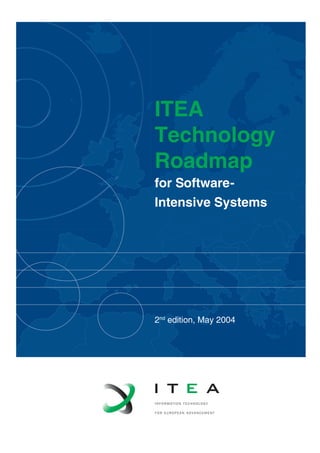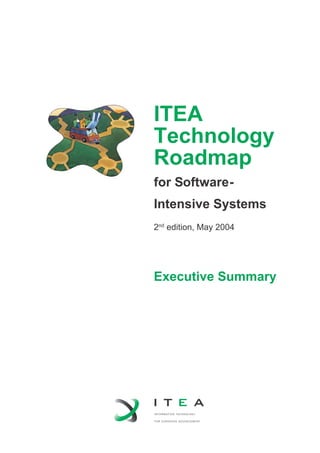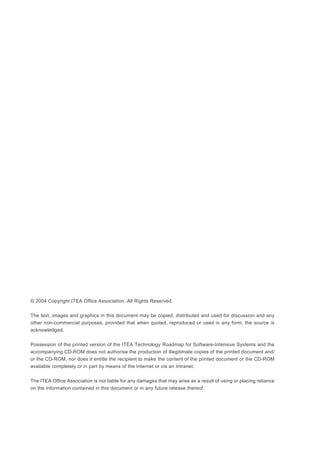The document is the executive summary of the second edition of the ITEA Technology Roadmap for Software-Intensive Systems from May 2004. It outlines the process used to update the roadmap, which involved developing scenarios of potential application evolutions, clustering results to outline software system evolutions, and structuring the analysis around application domains and technology clusters. It summarizes the findings in terms of the four technology clusters: content, infrastructure and basic services, human-system interaction, and engineering. For each cluster it provides a brief description and table outlining the major challenges.







![ITEA Technology Roadmap
for Software-Intensive Systems
© 2004 IOA6
To make it meaningful and to structure the process, we used two classifications: five Application Domains
[covered in Appendices 2 to 6] and four Software Technologies Clusters [covered in Chapters 2 to 5].
Together, these cover the field of software-intensive systems as completely as possible, keeping some
distance both from specific products (so as to avoid potential conflicts regarding Intellectual Property Rights
[IPR]) and also from current trends (e.g. in architecture or computer languages).
Both editions of the Roadmap use the same Application Domains, Technology Clusters and Technology
Categories which are used to classify ITEA projects.5
The main Technology Clusters are arranged around four
basic questions:
1. Which end-to-end technologies are required to acquire, process and store content?
The CONTENT cluster is articulated in three technology categories [see Table of Contents], and deals with
signals, data, information, documents and knowledge from capture to complete processing.
2. Which technologies are required to transport and distribute content?
The INFRASTRUCTURES & BASIC SERVICES cluster, articulated in four technology categories, deals with
transport mechanisms and protocols, as well as with the management of networks (including security).
3. Which technologies are required to build effective user-system interfaces?
The HUMAN-SYSTEM INTERACTION cluster contains a single technology category, which deals with the
interaction between human beings and the appliances and systems that support the services.
4. Which technologies are required to engineer software-intensive systems?
The ENGINEERING cluster is articulated in three technology categories. It explores the complexity of
engineering processes and deals with the creation of end-to-end services.
To make it successful, the Roadmap 2 process needed the full support of the ITEA constituency.
• Members of the various ITEA bodies provided experts to join the Core Team in charge of elaborating working
documents; 17 high-level individuals came together in 15 two-days meetings and contributed regularly to a
dedicated website. To validate and enhance the documents, the Core Team held four workshops, meeting
the ITEA Steering Group and other experts from industry – over sixty people in total.
• During two 2-days workshops, high-level experts from top European universities, research centres and
similar national programmes reviewed and supplemented the intermediate and final results.
• Public Authorities in the Netherlands and France provided financial support over the two-year period.
Evaluation of a range of technologies identified the main issues and challenges for software-
intensive systems.
The new Roadmap presents its findings in terms of four technology clusters. These are summarised in the
following sections, first with a brief presentation of the cluster, followed by a table, which briefly recaps the main
challenges. A final paragraph presents the main conclusions.
5
With some fine-tuning of names and definitions over time. For an introduction to these see the IRIS Book, which can be
downloaded from www.itea-office.org.](https://image.slidesharecdn.com/8df83082-498a-4498-8041-b5142996f517-150109045610-conversion-gate01/85/Executive-Summary-ITEA-Roadmap-2-8-320.jpg)
![Content categories Category definition Major challenges
Content Acquisition & Processing Technologies that are relevant to
acquiring, transforming and modifying
content.
Digital sensory system; capturing and
managing contexts; efficient analysis of
data, integration of information.
Content Representation Technologies for representing and
structuring data while at the same time
making the most appropriate and efficient
use of resources.
Generic structuring of data; integrated
multimedia streams; distinction between
content and presentation of data;
semantic data; semantic classification of
content; virtual re presentation of real-
world items; virtual/augmented reality;
cyber representation of active entities.
Data & Content Management Technologies for managing and retrieving
content while ensuring data integrity
in dispersed and heterogeneous
environments.
Guaranteeing the integrity of data,
intellectual property management and
protection; certification of content;
offering unique virtual identity capabilities
and management of the context; personal
or professional content management and
intelligent search.
Major challenges for Content technologies / Table ES-1
© 2004 IOA 7
ITEA Technology Roadmap
for Software-Intensive Systems
CONTENT
In general, content is whatever is exchanged within the environment of the system, or between systems. It is
processed, stored, managed and transformed. Content ranges from analogue signals to huge multimedia data
depositories.
The volume of digital content is growing rapidly. We are entering the era of high-quality, high-definition
multimedia streams – the most challenging and resource-demanding kind of content we know. Overall,
there are two reasons for this explosion of content: first, the infrastructure for capturing content is spreading
[see Digital Sensory System]; second, storage is available at very low cost, while accessible bandwidth is
continuously increasing.
Content is available at different levels of abstraction, i.e. signal, data, information, and knowledge. It should
be easily accessible and needs to be managed with sophisticated technologies (e.g. efficient searching and
consistency management) in distributed and heterogeneous environments.](https://image.slidesharecdn.com/8df83082-498a-4498-8041-b5142996f517-150109045610-conversion-gate01/85/Executive-Summary-ITEA-Roadmap-2-9-320.jpg)


![ITEA Technology Roadmap
for Software-Intensive Systems
© 2004 IOA10
larger, more networked and more dynamic – whereby users may find them less predictable. To address this
concern, security will become pervasive, and will be handled at all stages of the software life cycle.
HUMAN-SYSTEM INTERACTION
Software-intensive systems are becoming more and more complex and, at the same time, more and more
people are using them. The interaction between the user and a system has a major impact on the acceptance
and usefulness of these systems. The method of interaction depends on a number of factors, some of which
themselves depend on the role of the user, the interaction device, the user’s experience and their environment.
A critical factor in the acceptance of information technology will be ease of access for non-technical users.
Consumers in the mass market require easier interfaces than technology innovators and early adopters.
User interfaces need to support multilingual versions in distributed, collaborative, multicultural and multi-
user environments, and must allow simple and quick authoring, navigation and access to multimedia data.
Particularly important are multimodal (referring to modalities such as sound and vision), adaptive, personalised,
scaleable user interfaces. New appliances, for example in intelligent Home and Nomadic devices and those
used in industrial applications and systems (process control, air traffic control, medical systems etc.) require
multimodal interaction.
In recent years, the games industry has also been particularly influential. Heavy competition and the demand
for ever better versions in very short cycles have stimulated the development of Human-System Interaction
(HSI), which comprises technologies that handle interaction with the user.
Even as people become increasingly familiar with complex systems, spending time coping with complexity is
becoming less acceptable. HSIs should therefore hide underlying complexities from users and provide the best
possible user experience, so that the user feels in control. A specific challenge here is to intelligently select
appropriate modalities and provide “zero configurability” within multidimensional environments consisting of
different networks and access technologies, devices, people and services. In addition, future user interfaces
will need to be able to learn user preferences and to store, manage and disseminate this information to
relevant related services and devices. This process needs to be secure and it must protect user privacy.
However, acceptance of new HSIs that replace familiar, although complex, ones will take time unless the new
HSIs can naturally support accepted modes of interaction.
In recent years, the various technologies have probably been overemphasised. For those who use them, it is
the entire user experience that determines whether the new technologies provide real added value or not. It
should also be noted that the added value usually comes indirectly through the services and applications that
intelligently apply the new technologies – not from the technologies as such.
Therefore, in order to be able to fulfil users’ needs and meet general requirements for future systems, the R&D
in underlying technologies [see Chapter 2 on Content] and platforms [see Chapter 3 on Infrastructures & Basic
Services] should be done in close cooperation with the R&D in user interface and interaction technologies
[see Chapter 4 on Human-System Interaction], and vice versa. Moreover, other disciplines outside the area of
software systems also need to be involved in the process so that software engineers can better understand
user requirements, transfer them into software systems and improve the acceptability of outcomes; this
includes, among others, behavioural science specialists and physiologists.](https://image.slidesharecdn.com/8df83082-498a-4498-8041-b5142996f517-150109045610-conversion-gate01/85/Executive-Summary-ITEA-Roadmap-2-12-320.jpg)
![© 2004 IOA 11
ITEA Technology Roadmap
for Software-Intensive Systems
In short, the target for the new HSIs is that they should be:
• simple, self-explanatory and easy to use
• intelligent, context-aware and adaptive
• seamless and interoperable.
The whole process should largely be user-driven, which also poses new demands for software and systems
design and engineering [see Chapter 5 on Engineering technologies and challenges].
ENGINEERING
Software-intensive systems are programmable systems based on one or more integrated controllers. Even
today, less than 10% of the controllers produced are built into computers. Most of them can be found in systems
such as cars, phones, washing machines, aircraft, robots, traffic systems, cameras and audio equipment.
And this trend towards programmable systems is accelerating. Software not only increases the variability,
configurability, extendibility and changeability of everyday systems, it will also soon allow for a greater variety
of functions based on the advanced information processing capabilities built into these systems.
Future systems will be even more dominated by software. As a consequence, the engineering and maintenance
process of software-intensive systems is undergoing dramatic changes because software is becoming not only
a major part of the product but also a central aspect of system engineering.
Embedding software into systems increases the complexity of these systems as well as the complexity of the
engineering process. Complexity becomes apparent whenever it becomes difficult to comprehend and manage
all the aspects, requirements, consequences, interrelationships and relations associated with a specific product
and the product creation process. It emerges from the combination of architecture decisions, restrictions on
existing physical resources, integration of legacy functionality, required non-functional properties and the use
of heterogeneous technologies.
In general, complexity increases the effort needed to develop products, services or infrastructure and
increases the already high tension between time-to-market and general development cost on the one hand
and the quality and adequacy of the product on the other. The effective engineering of efficient, reliable and
safe systems is essential and needs support from appropriate technologies, such as methodologies, notation
languages, design and implementation techniques, generation techniques, tools, knowledge, processes,
guidelines and maintenance support.
Although the integration of hardware and software will present system engineers with new challenges, many of
the engineering problems mentioned above are mostly software-related. This is partly due to the focus of this
Roadmap but it also reflects the fact that software engineering is still a very young discipline.
Progress in software engineering support will depend on advances in methodologies, models, tools and
implementation techniques that support the efficient implementation of embedded systems and services.
Engineering technology will require techniques for mastering complexity and capturing high-level specifications
of distributed systems. It will also require implementation tools that, firstly, support short time-to-market
development cycles, and secondly, guarantee not only cost-efficient, resource-limited implementation on a wide
variety of platforms, but also design flows that supports the development process in multi-disciplinary teams.](https://image.slidesharecdn.com/8df83082-498a-4498-8041-b5142996f517-150109045610-conversion-gate01/85/Executive-Summary-ITEA-Roadmap-2-13-320.jpg)

![© 2004 IOA 13
ITEA Technology Roadmap
for Software-Intensive Systems
A simplified conclusion of the findings of this Roadmap
In years to come, software-intensive systems will incorporate four basic features (compared to their current status):
• They will be dynamic evolutionary systems.
• They will exhibit adaptive and anticipatory behaviour.
• They will process knowledge and not only data.
• They will allow the user to stay in control.
There are two kinds of keys to the development and deployment of these systems:
• Key drivers for acceptance are
- interoperability of products, systems and applications
- the “-ilities” – security, usability, testability, reliability – and safety
• Key issues for implementation are
- mostly technical: mastering size, complexity and adaptiveness
- mostly economic: middleware business models and costs
At the crossroads of technology and business: the challenge for the years ahead
Our work on this second edition of the ITEA Roadmap for Software-Intensive Systems has confirmed most
of the findings of the first. It has been possible to validate the gradual evolution that we then described:
“Our technological environment will become, step by step, more and more networked and more and more
autonomous and self organising […] From now on to this long-term vision, generally two stages may be
foreseen […]: the self configurability and interoperability of the terminal devices and the integration of the
different networks.” 7
The evolution of applications during the past three years has confirmed the projections
made in the previous document [see Figure ES-1].
Dynamic
interoperability
"Islands"
Separated access points
Broadband access
Universal access
Nomadic personal access
Integration
"Plug & Play"
Seamless Integration
MORE AUTONOMY
M
O
R
E
SELF
M
A
N
A
G
EM
EN
T
Total interoperability
as a service
Selective
interoperability
Specific
Isolated
Depending on operator Flexible and easy to extend access points Personal access control
Infrastructures & services
Terminaldevices
The road towards convergence / Figure ES-1
7
From page 4, Technology Roadmap on Software Intensive Systems, ITEA, March 2001](https://image.slidesharecdn.com/8df83082-498a-4498-8041-b5142996f517-150109045610-conversion-gate01/85/Executive-Summary-ITEA-Roadmap-2-15-320.jpg)


